Native Title Report 2008: Climate change, water and Indigenous knowledge - A Community Guide to the Native Title Report 2008
Archived
You are in an archived section of the website. This information may not be current.
This page was first created in December, 2012
Native Title Reports 2008
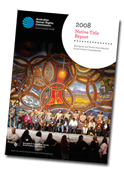 Climate change, water and Indigenous knowledge: A Community Guide to the Native Title Report 2008
Climate change, water and Indigenous knowledge: A Community Guide to the Native Title Report 2008
Please be aware that this publication may contain the names or images of Aboriginal and Torres Strait Islander people who may now be deceased.
A note from the Commissioner
One of the most critical issues facing Australia is the challenge of our changing climate. Closely linked to this is the need to carefully manage our precious water resources.
Climate change presents a unique risk to the livelihoods of Aboriginal and Torres Strait Islander peoples (and indigenous peoples worldwide).
As coastal and island communities confront rising sea levels, and inland areas become hotter and drier, Aboriginal and Torres Strait Islander peoples face the loss and degradation of the lands, waters and natural resources they have relied upon for generations.
It also poses a major threat to the physical health of Indigenous communities and our ability to sustain our traditional life, languages, cultures and knowledge.
Further, efforts to tackle climate change have the potential to entrench our economic marginalisation by exploiting Indigenous traditional lands, waters and natural resources ‘in the national interest’.
There is a lot at stake – and yet Indigenous Australians are often sidelined when it comes to the important work of developing policies and plans to respond to these pressing challenges. This has to change.
The Native Title Report 2008 explores the issues of climate change and water resources, and what the government’s policies might mean for Aboriginal and Torres Strait Islander peoples.
Our communities require specific support to put in place measures to adapt to climate change. However, we also have new opportunities, mainly through our traditional knowledge, to participate in emerging carbon markets and further mitigation efforts.
This year’s report includes two case studies – one from the Torres Strait Islands and the other from the Murray-Darling Basin – which highlight the particular challenges and opportunities for Aboriginal and Torres Strait Islander communities.
In different ways, they both point to the need for Australia’s climate change response to protect fundamental human rights, especially the rights of those who are the most vulnerable.
The United Nations Permanent Forum on Indigenous Issues has stated that indigenous peoples have the smallest ecological footprints of the world’s communities and should not be asked to carry the ‘heavier burden of adjusting to climate change.’
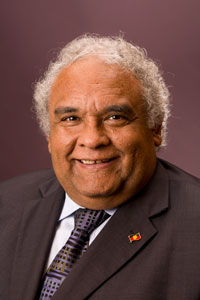 Tom Calma is the Aboriginal and Torres Strait Islander Social Justice Commissioner.
Tom Calma is the Aboriginal and Torres Strait Islander Social Justice Commissioner.
Tom, an Aboriginal elder from the Kungarakan tribal group and a member of the Iwaidja tribal group of the Northern Territory, commenced his five-year term in July 2004.
As Commissioner he advocates for the recognition of the rights of Indigenous Australians and seeks to promote respect and understanding of these rights among the broader Australian community.
Tom has been involved in Indigenous affairs at a local, community, state, national and international level and has worked in the public sector for over 35 years.
Climate change and water: Engaging Aboriginal and Torres Strait Islander peoples
The consensus of the world’s climate scientists is that man-made greenhouse gas emissions are creating significant changes in the global climate system. Higher temperatures, rising sea levels and more extreme storms will fundamentally change where and how we live.
International human rights law recognises and protects the distinct rights of indigenous peoples whose way of life comes under threat from particular circumstances, such as climate change.
At the 7th Session of the United Nations Permanent Forum on Indigenous Issues, held in April 2008, the issue of climate change and indigenous people was placed firmly on the international agenda.
At the session, indigenous peoples from across the globe, shared the concern that they would bear the brunt of climate change impacts, while at the same time being called upon to share their traditional knowledge on biodiversity and land management to develop national mitigation strategies.
The forum concluded that mitigation and adaptation strategies must be ‘holistic and take into account not only the ecological dimensions of climate change, but also the social impacts, human rights, equity and environmental justice.’
The Declaration on the Rights of Indigenous Peoples was adopted by the United Nations General Assembly in September 2007.
The Declaration supports the full participation and engagement of indigenous peoples in the development and implementation of national and international policy. This will be particularly important for Aboriginal and Torres Strait Islander peoples in responding to climate change.
Building genuine partnerships
Climate change poses a major threat to Aboriginal and Torres Strait Islander lands, waters and resources in Australia, as well as the maintenance of their traditional life, languages and cultures.
It is clear that Indigenous Australians are major stakeholders in developing and advancing a national climate change policy. To date, however, there has been little attempt to foster genuine, coordinated and sustained participation by Aboriginal and Torres Strait Islander peoples.
This omission needs to be rectified because:
- a human-rights approach means that Indigenous peoples will be actively engaged in all levels of management and decision-making that affects their livelihoods and communities.
- engaging and supporting Indigenous peoples is essential to ensure the effectiveness of adaptation and mitigation strategies for both Indigenous communities and the broader Australian community.
- reducing greenhouse gases and carbon abatement will rely heavily on Indigenous lands and waters.
- Indigenous traditional knowledge, land management and conservation practices will be crucial to responding to climate change, maintaining biological diversity and preserving important ecosystems.
New opportunities: ‘Culture based’ economies
While the impacts of climate change are potentially devastating for Indigenous communities, there are also opportunities to contribute to mitigation efforts and develop ‘culture based’ economies in areas such as biodiversity conservation, land and water management and carbon sequestration.
In Northern Australia, culture based economies are already providing important environmental services that meet Indigenous peoples’ aspirations and serve the national interest.
For example, the WALFA Project in Western Arnhem Land, where savanna burning is mitigating wild fire, has resulted in economic, cultural, social and environmental benefits for Indigenous people and the wider Australian community.
Programs such as the Caring for Country Initiative, the Working on Country Program and new national park joint management arrangements in Cape York are utilising Indigenous traditional knowledge to manage land and sea country. It also provides genuine economic opportunities for the communities in those regions.
There is significant scope to further develop these culture-based economies, as part of emerging climate change responses which include emissions offsetting and carbon trading.
However, Indigenous engagement in national and international carbon and emissions trading markets will require the development of national principles to protect Indigenous peoples’ rights.
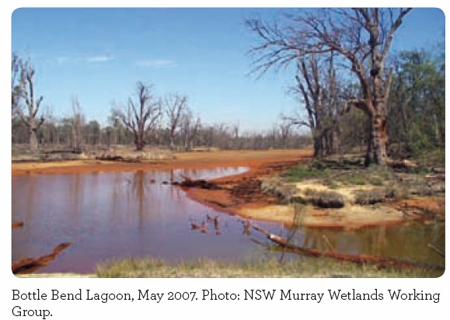
Protecting Indigenous water rights
Water is the life for us all. It’s the main part. If we are gonna lose that I don’t know where we gonna stand. If that water go away, everything will die. That’s the power of water.
John ‘Dudu’ Nangkiriyn
Bidyadanga, Western Australia
Like climate change, securing access to water resources is an issue facing communities around the globe.
The predicted impacts of climate change in Australia – more droughts, higher temperatures and greater evaporation – will exacerbate the growing stress on our river and marine systems.
Indigenous Australians’ water rights are at severe risk from climate change – and this will simply compound problems created by Australia’s long history of water mismanagement, through artificial control of major waterways and over-allocation of water licences.
This mismanagement has disrupted the natural flows which many Indigenous communities rely upon to maintain the health of the waterways and surrounding ecosystems – the foundation of their social, cultural, spiritual and economic life.
Access to cultural water (see page 6 for definition) is vital for the well-being of Indigenous peoples and their ability to care for country. When river systems decline, so does the culture of the Indigenous peoples whose lives depend on the river systems. Indigenous communities lose traditional sources of food and medicines, sacred sites are compromised and opportunities for economic development are diminished.
As water-related legislation and policy is developed, it is crucial that governments take steps to ensure the genuine participation of Indigenous peoples and that Indigenous priorities and needs, such as cultural water rights, are considered and protected.
The National Water Initiative (NWI) is Australia's blueprint for water reform. Through it, Australia’s governments have agreed on steps to achieve a more cohesive national approach to the way water is managed, measured and traded.
The NWI allows for access to, and management of, water by Indigenous people. However, while the NWI ensures that native title rights are recognised, recognition and provision of other Indigenous water rights and priorities are discretionary.
Case study 1
The Torres Strait Islands: Averting a human rights crisis
The Torres Strait Islands include more than 100 islands, spread between the Cape York Peninsula and the coast of Papua New Guinea. More than 7,000 people live in 19 communities across 16 islands. Each community is a distinct peoples, with unique histories, traditions, laws and customs.
The Torres Strait is home to the group of Islanders from Mer who first won recognition of native title, with Eddie (Koiki) Mabo initiating the ground-breaking land rights case.
The people of the Torres Strait Islands live with an uncertain future. If urgent action is not taken, they face the very real possibility of a human rights crisis.
Islanders have expressed their concerns about the impact of climate change and the visible changes that are already occurring: increased erosion, strong winds, land accretion, increasing storm frequency and rougher seas of a sort that elders have never seen or heard of before.
They are seeing the effects of a changing climate on the local flora and fauna and feel that their physical and cultural lives are under threat.
Because of its unique geography – many of the low-lying coral cays are only a couple of metres above sea level – the Torres Strait Islands will be an inadvertent litmus test for national and international efforts to respond to climate change.
We see the big trees near the beach ... falling down. The seagrass that the dugongs eat – you used to find long patches of it – but not anymore. The corals are dying and the sand is getting swept away and exposing rock.
Ron May
Murray Island elder
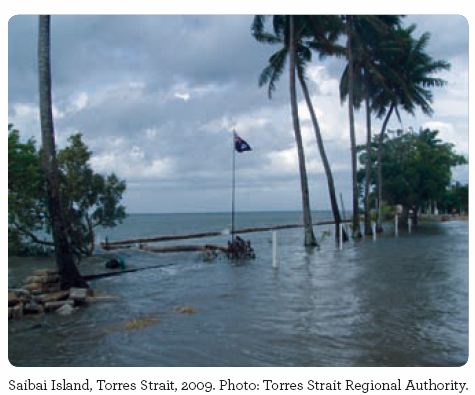
The impact of climate change
The predicted rise in temperatures, sea levels and severe weather events will potentially affect every aspect of life on the Torres Strait Islands, including:
- reduced availability of freshwater
- inundation or destruction of essential infrastructure, such as housing, sewerage and power, as well as roads and airstrips
- greater risk of disease from flooded rubbish tips and disease-borne insects from the tropical north
- degradation of significant cultural sites, such as graveyards near the shoreline
- change in the location or abundance of animals and plants, such as turtles, dugongs and mangroves, and the complete loss of some plants and animals
- inability to travel between islands.
These changes will profoundly affect the ability of these communities to enjoy many of the basic rights that other Australians take for granted, such as the right to life, health, food, water, culture and a healthy environment.
The potential that some communities may need to relocate – either within the Islands or to mainland Australia – raises important economic, social and cultural considerations that governments must factor into its climate change planning.
Equipping Indigenous communities
It is widely recognised that Indigenous communities are much more vulnerable to climate change because of the social and economic disadvantage they already face.
Due to the remoteness of the Torres Strait Islands, communities do not have access to the same services and infrastructure as other Australians.
It is clear that these communities will need particular help from government to develop and put in place effective strategies to adapt to their changing environment.
A human rights based approach can easily be integrated into the various stages of the ‘adaption as a process’ model, developed by the Intergovernmental Panel on Climate Change, which includes:
- providing information, knowledge and data
- undertaking risk assessments
- mainstreaming adaptation into plans and policies
- evaluation and monitoring for feedback and change
- building awareness and capacity.
All of these areas have been identified as lacking in the Torres Strait, and the communities have identified them as urgent priorities.
The lessons to be learned from preparing the Torres Strait for climate change will have wide application – there are 329 discrete Indigenous communities across Australia located within 10 kilometres of the coast, with the majority located in remote locations.
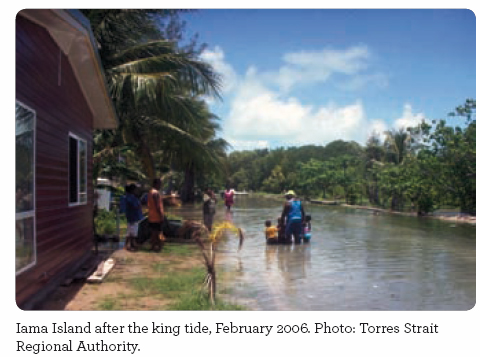
New study: Climate change and northern Australia’s Indigenous communities
Recognising the importance of this issue, the Australian Government is funding a study on ‘how climate change will impact on Indigenous communities in northern Australia’, including the Torres Strait.
It will take a more holistic approach than most climate change research to date, examining the impacts on health, the environment, infrastructure, education, employment and opportunities that may arise from climate change.
The results of the study should help set government priorities and action for the region.
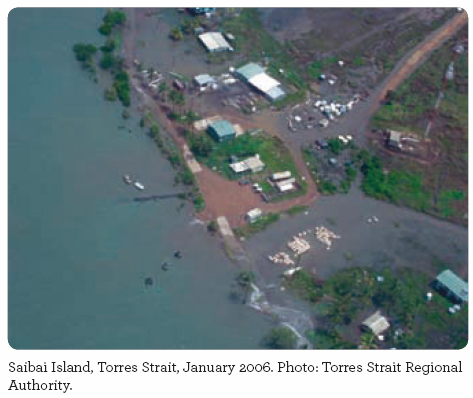
Legal remedies for disappearing land
Less than 20 years ago Australian law did not recognise Torres Strait Islanders’ rights to their land. But the Islanders fought for their rights through the courts and won.
Today, however, it is the sea – not the law – that threatens to take away their land. And, once again, the Islanders may want to consider how they can enforce their rights if government action is inadequate.
There are currently no laws in Australia that specifically protect people from climate change impacts but there may be other laws the Islanders can use to seek a remedy.
The Native Title Report 2008 explores some of the legal avenues that are potentially open to the people of the Torres Strait, including the Native Title Act, the Queensland Environmental Protection Act, the tort of negligence, the tort of public nuisance and international human rights law.
Case study 2
The Murray-Darling Basin: Sharing water resources fairly
The Murray-Darling Basin, located in south-east Australia, covers close to 14 per cent of the country’s total area. It provides drinking water to over three million people and accounts for almost 45 per cent of the value of Australia’s agricultural output.
The Murray-Darling River Basin is in a state of crisis and ecological stress.
Extensive land and water mismanagement, significant human manipulation of the river system and over-allocation of water licences have all contributed to the current fragile state of the river.
This has been compounded by the large amounts of groundwater and surface water that have been extracted over the years for use by industry, agriculture and communities.
The predicted effects of global warming – reduced annual flows and increased evaporation – will only add to extreme stress that the river system is under.
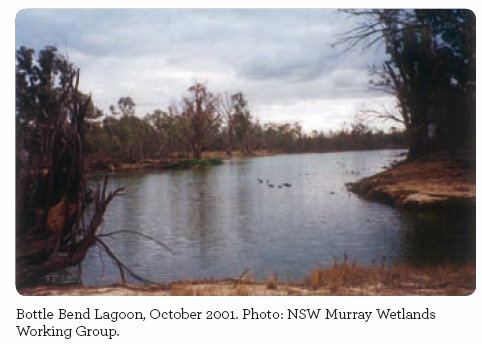
Challenges for Indigenous communities
The Murray-Darling Basin is home to some 40 autonomous Aboriginal Nations across the five states and territories. Aboriginal peoples in this area make up 3.4 per cent of the Basin’s total population and 15 per cent of the national Indigenous population.
The continuing decline of the river system poses a direct threat to the human rights of these Indigenous communities. They have particular concerns about:
- the health of fragile ecosystems, including the many wetlands and river red gums
- the recognition and provision of cultural water rights, in order to maintain their culture and the environment
- their ability to participate in the cultural economy.
With the likelihood of more droughts and reduced flows, it will become increasingly important to promote greater understanding and recognition of Indigenous cultural water rights and the unique spiritual and cultural relationship that Indigenous peoples have with the river system.
As Matt Rigney, a Ngarrindjeri man, has explained:
We are of these waters, and the River Murray and the Darling and all of its estuaries are the veins within our body. You want to plug one up, we become sick.
The fundamental goal of these Indigenous communities is to restore the river system to a state of health so they can maintain their traditional culture. In recent years, a lack of regular flows has decimated traditional sources of food and medicines and caused significant damage to spiritual sites.
While current legislative arrangements make provision for ‘environmental water’, there is limited consideration given to social and cultural needs of Indigenous communities.
Provision for cultural water would support Indigenous peoples of the Murray-Darling to use their traditional knowledge to care for the ailing river system and the surrounding ecosystems. This has benefits for everyone in the region.
What is cultural water?
The Indigenous Nations of the Murray-Darling Basin define cultural flows as ‘water entitlements that are legally and beneficially owned by the Indigenous Nations of a sufficient and adequate quantity and quality to improve the spiritual, cultural, environment, social and economic conditions of those Indigenous Nations.’
However, cultural water is also a matter of social justice. It recognises the unique connection of Indigenous communities to their land and allows them to fulfil their responsibilities to care for country. It provides them with the ability to decide where and when water should be delivered, based on their traditional knowledge.
The Indigenous Nations of the Murray-Darling intimately understand the stress that the river system is under and the volume of water required to bring it back to health. They also recognise the many competing pressures for water.
Healthy rivers also have the potential to provide commercial opportunities for the region’s Indigenous people, in areas such as eco-tourism, cultural tourism, native nurseries and seed collection.
Working together
The Murray Lower Darling Rivers Indigenous Nations (Aboriginal Corporation) (MLDRIN) was formed in 1998, in response to the High Court’s Yorta Yorta native title decision.
An alliance of 10 traditional owner groups in the lower southern part of the Murray-Darling Basin, it provides a united voice for the rights and interests of the groups’ traditional country and its people.
One of MLDRIN’s key roles is to provide input and advice to various state and federal government agencies, including the Murray-Darling Basin Commission, on natural resource management.
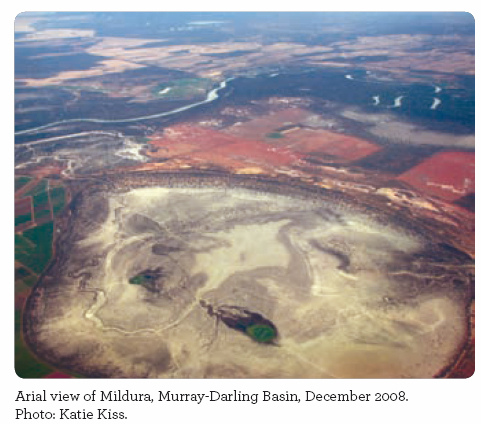
The significant work done by MLDRIN to develop effective working relationships with governments and their agencies has also resulted in greater awareness and support for the aspirations of traditional owners.
This is reflected in the Memorandums of Understanding MLDRIN signed with the former NSW Department of Land and Water Conservation (2001) and the Murray-Darling Basin Commission (2006).
The experience of MLDRIN in negotiating with governments on issues of concern to the Indigenous peoples of the Murray-Darling River Basin provides a useful model for other Indigenous groups around the country, especially while the national dialogue about water and climate change policy is at this critical stage.
Cultural perspectives need to be taken into account in the long term management of natural resources. Managing the Murray and Lower Darling Rivers requires decisions that go beyond a site-by-site approach.
The Right Hon. Ian Sinclair AC
President of the Murray-Darling Basin Commission
Next steps
A lot of work is required to turn around the health of the Murray-Darling Basin. For the region’s Indigenous communities, these efforts are urgent and critical.
Three key elements that must be a part of this strategy include:
- genuine engagement of the region’s Indigenous peoples in decision-making and problem-solving, including their participation on relevant government committees
- research on the impact of climate change on Indigenous peoples and on the sustainability of the environment
- appropriate environmental flows and enforceable cultural water allocations.
Protecting Indigenous traditional knowledge
Over the millennia, indigenous peoples around the world have developed a close and unique connection with the lands and environments in which they live. The same is true in Australia – and it is clear that this traditional knowledge will be a valuable resource in national climate change mitigation efforts.
However, the current legal system does not adequately recognise or protect Indigenous Australians’ collective knowledge.
Existing intellectual property laws offer only limited scope for the recognition of Indigenous peoples’ rights in relation to biodiversity knowledge and practices. And while native title, cultural heritage and environmental laws provide some recognition and protection, it is not sufficient.
With significant challenges ahead, particularly in relation to climate change and water management, specific legislation is urgently required that can provide effective protection for Indigenous traditional knowledge and clear protocols around its use, access and ownership.
The Western Australian Law Reform Commission has developed a set of principles which provide a firm foundation for effective protection of Indigenous traditional knowledge.
They include the need to:
- undertake direct consultation with Indigenous peoples regarding their customary law and other requirements and to ensure compliance with these
- seek free, prior and informed consent for the use of any Indigenous traditional knowledge from the custodians of that traditional knowledge, as well as for access to traditional lands and waters
- ensure ethical conduct in any consultation, collection or other processes
- ensure the use of agreements on mutually agreed terms with Indigenous peoples for all parts of the process
- devise equitable benefit-sharing arrangements and acknowledge the contribution of Aboriginal peoples.
As well as protecting the use of Indigenous traditional knowledge, it is also crucial to preserve this knowledge before it is lost. In different parts of the country, Indigenous communities have been recording their traditional knowledge so it can be shared with following generations.
The Desert Knowledge Cooperative Research Centre has developed a comprehensive Protocol for Aboriginal Knowledge and Intellectual Property, which provides a very useful guide for ‘best practice’ approaches in ethics, confidentiality, equitable benefit sharing and managing research information.
The Traditional Knowledge Revival Pathways uses a grassroots methodology to record and preserve the knowledge of traditional owners about biodiversity and ecosystems in Cape York. The project aims to transfer this knowledge from elders to their young people, as well as incorporate it into cooperative land management strategies.
Find out more
The Native Title Report 2008 examines in detail the topical issues of climate change, water resources and the way in which Indigenous traditional knowledge can be used to respond to these challenges.
The Native Title Report 2008 is available at www.humanrights.gov.au/social_justice/nt_report/ntreport08/
To order hard copies and CD-ROMs of the Native Title Report and for additional copies of this Community Guide call 1300 369 711 or order online at: www.humanrights.gov.au/about/publications/
If you have comments or feedback please email us at socialjustice@humanrights.gov.au or complete the online survey at: https://humanrights.gov.au/about/contact (Native Title Report 2008 Feedback)
For more information about the Australian Human Rights Commission, please visit www.humanrights.gov.au; or write to:
Social Justice Unit
Australian Human Rights Commission
GPO Box 5218
Sydney NSW 2001
